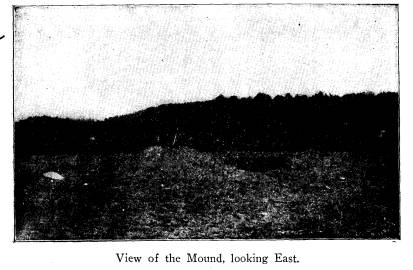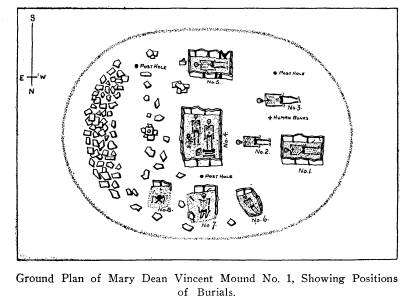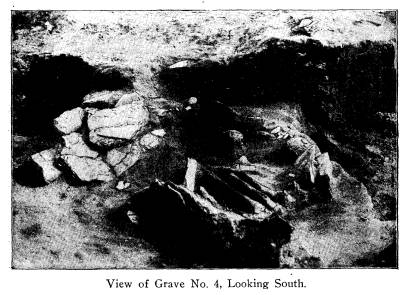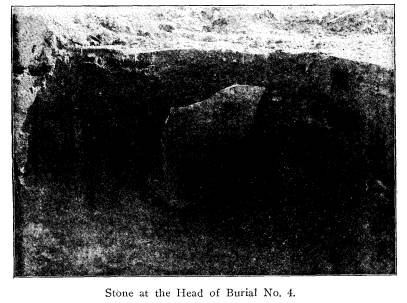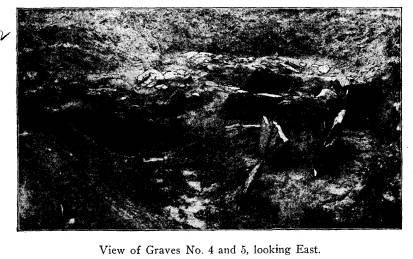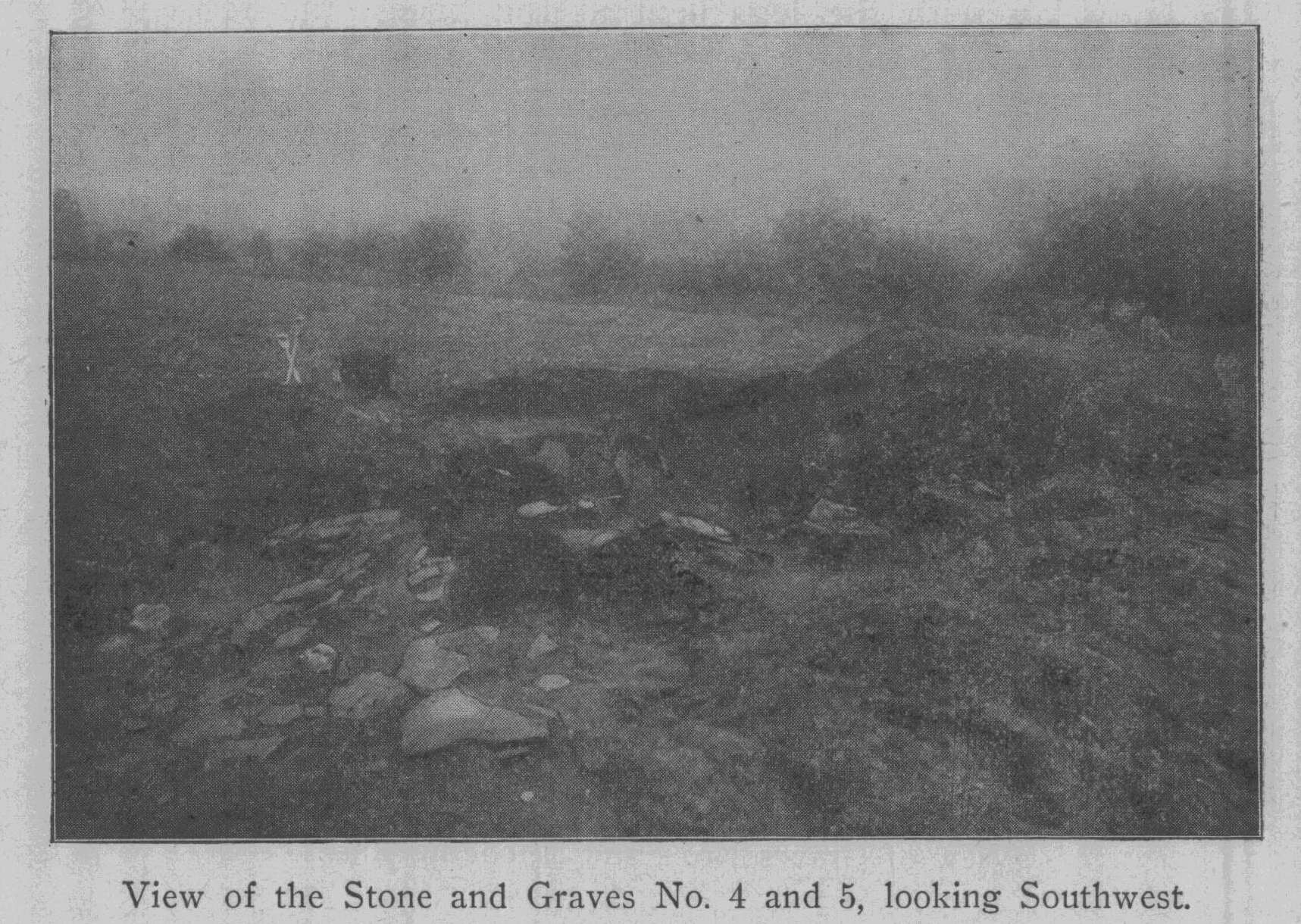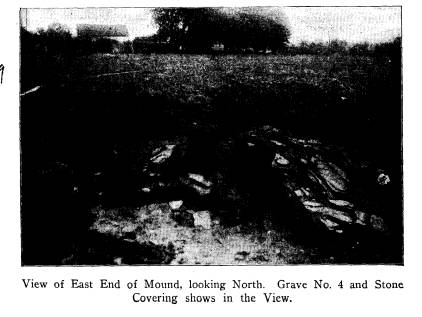Ohio History Journal
MARY DEAN VINCENT
MOUND.
A. B. COOVER.
[Mr. Coover is a Life Member of The Ohio
State Archaeological and
Historical Society and has assisted
Prof. W. C. Mills in many of the
archaeological explorations made by the
Society. Mr. Coover acted as
Curator of the Museum of the Society
during the absence of Prof. Mills
while in charge of the Society's exhibit
at the Jamestown Exposition.
It was during this time that Mr. Coover
made the explorations herein
described. - EDITOR.]
Under directions of the Secretary of the
Ohio State Archae-
ological and Historical Society, I left
Columbus on Wednesday,
October 2d, for Beverly, 0., to
investigate the finding of skele-
tons at the Mary Dean Vincent mounds in
Washington county.
Upon my arrival at the home of Mr.
Vincent I found that the
description of the find as printed in
the Beverly Dispatch under
the date of September 20th was correctly
stated; a part of this
description I incorporate in my report.
"Mr. E. B. Vincent, a prominent
farmer who resides three miles
above Beverly on the west side of the
Muskingum river, while working
in a field a few days ago, came in
contact with a large stone, standing in
a perpendicular position. On
investigation he found that the stone was
part of an enclosure which proved to be
a prehistoric grave, eight feet
long, four feet wide and two feet deep.
This grave was enclosed with
stones ranging in size from one to two
feet square.
"Within the grave Mr. Vincent found
a skeleton in a fair state of
preservation and surrounding it were
several rare prehistoric relics.
Among these were two fine spearheads
-one white and the other black -
four inches long and perfect in every
respect; a gorget (celt) of fine pol-
ish, five inches long; and several stones
of a hard granite substance with
perforations, probably used as
ornaments. Nearly all these relics were
found around the head and shoulders
pointing toward the remains.
"Mr. C. L. Bozman, a life member of
the Ohio State Archaeological
and Historical Society, with Mr. Corner,
photographer at Beverly, drove
up to the site on Monday and secured
photographs of the remains as they
were found.
"About one hundred yards north of
the grave where the remains
were found, there is a prehistoric mound
known to all older citizens as
(36)
|
Mary Dean Vincent Mound. 37
one of rare prominence. The mound is 70 x 80 feet and 7 or 8 feet high, and is known as the Mary Dean Vincent mound, having been named in honor of the daughter of Mr. Vincent, owner of the farm. The farm was at one time owned by Equal Bacon, deceased, and was purchased by Mr. Vincent a number of years ago. "Mr. Vincent, through Mr. Bozman, has kindly donated this mound to the Ohio State Archaeological and Historical Society for exploration purposes." The Mary Dean Vincent mounds are located on the Mus- kingum river in Waterford township, Washington county, near |
|
|
|
the southern extremity of a sand ridge, which extends north and south for a distance of about one and one-half miles, and is some three hundred yards wide and fifty feet above the level of the river at this point. The valley is about one-half mile wide and from the elevated position of the mounds a commanding view north, east and south is obtained, while some three or four hun- dred yards to the west, and across a narrow ravine which divides the sand ridge from the upland, rises a densely wooded hill some three or four hundred feet high. There are two mounds on the ridge, some two hundred yards apart. The land has been under cultivation for about |
|
38 Ohio Arch. and Hist. Society Publications. seventy-five years, and the mounds have been greatly reduced in height. Mound No. 1, which has just been opened, was thirty by twenty-four feet and about eighteen inches high. Mound No. 2 lies directly north of No. 1, and is a fine specimen of an oblong mound seventy by eighty feet and seven or eight feet high. The stone used in making the stone graves are slabs of sandstone from one to two feet in diameter and one to two inches thick, and were carried from the adjacent hillside where it out- crops. |
|
|
|
Following the find of the first burial, Mr. Vincent later dis- covered a second skeleton which he and Mr. Bozman uncovered and left in place until my arrival. The second skeleton lay at full length with the head to the east. There was no stone placed around this burial, neither were there any artifacts placed with it; but at the depth of about ten inches and two feet south, was found a small sandstone tablet which had been broken. The bones being in a bad state of pres- ervation I was unable to obtain a photograph of the skeleton. |
|
Mary Dean Vincent Mound. 39
Directly south of graves No. 1 and 2 was found a slight trace of a body having been buried, the soil being discolored and a very small fragment of human bones was all that was left to tell the story. The third burial was found on the southwest side of the mound; the skeleton lay at full length with the head to the east. There was no stone placed around this burial. The bones were very soft and crumbled at the least touch. Near the remains was found a small stone celt, one arrowpoint, and a nicely fin- |
|
|
|
ished flint scraper. Several quartzite pebbles and numerous flint chips were also found near by. The fourth grave was the most peculiar one of all that was found in this mound, and contained three skeletons. A stone en- closure had been set up and in it placed two bodies lying at full length, with the heads to the south. The third skeleton in this burial was a dismembered one, and had been buried after the flesh had been removed from the bones. Two femurs and an humerus, with a part of the innominate bones, were placed two inches above one of the skeletons and an enclosure of small sand- |
|
40 Ohio Arch. and Hist. Society Publications. stone slabs placed around them, while the remainder of the skele- ton was found in a heap nearby and on a level with the other skeletons, near the skull of one and between the two skele- tons, was found six flint arrow and spearpoints; a flint chisel four and one-half inches long; a beaver tooth which may have been used as a chisel; one bone bead made from the wing bone of a bird, and a piece of deer bone about three and one-half inches long. Scattered through the earth, and within the stone |
|
|
|
enclosure, were found several fragments of pottery. The top of this grave was within six inches of the plow line and the bones were so badly decomposed that they crumbled soon after being exposed to the air. The fifth grave was southwest of the fourth burial and near the edge of the mound. Stones had been nicely placed to form a grave seven feet long by nineteen inches wide, and contained the skeleton of an adult who in life was about five feet and ten inches tall. The bones were mostly in a poor condition, with the excep- tion of a few ribs that were found under a flat stone which had |
|
Mary Dean Vincent Mound. 41
fallen over that part of the body. One broken arrowpoint was all that was found with this burial. Burial No. 6 was that of a very young child which had been placed within a small stone enclosure north of the center of the mound. A few teeth, which were soon turned to dust upon ex- posure to the air, and the discolored soil, was all that remained to show that the body had been placed in its grave. Burial No. 7 was near the edge and on the north side of the mound. The grave was only partly enclosed with stone slabs. The body lay with the legs bent at the knees, the feet lying |
|
|
|
directly under the femurs. The right humerus was separated from the body and lay eleven inches east of the head. Two feet east of burial No. 7 was found the eighth and last grave, which was partly surrounded by stone and contained a skeleton the bones of which had been placed within a space eighteen by twenty-four inches. This was the skeleton of a child perhaps ten years of age, and had been buried after the bones had become separated. The skull lay near the center of the heap of bones with the teeth up; while the lower jaw was found some thirteen inches to the south of the skull. |
|
42 Ohio Arch. and Hist. Society Publications.
The eastern end of the mound was covered with flat stone for a distance of ten feet, and may have originally extended some distance farther west, as at this point they were within reach of the plow and may have been carried away by this means. Under this covering of stone was found a seam of dark colored earth, several inches thick, which may have been decomposed vegetable matter; but no bones or other objects were found beneath them. Scattered throughout the mound, and having no seeming relation with the burials, were found numbers of stones showing |
|
|
|
the action of fire; flint chips; several arrowpoints, and broken stones which show evidence of having been worked by the hand of man. Small pieces of charcoal were found in various parts of the mound; but not more than a handful of ashes were found throughout the entire work. Three post holes about six inches in diameter and twelve to fourteen feet apart in the form of a triangle were located as shown on the sketch of the mound. Al- though a careful lookout was kept for any signs of a wooden |
|
Mary Dean Vincent Mound. 43
enclosure having been built on the site of the mound, nothing was found except the three post holes mentioned above. I cannot close this report without expressing my indebted- ness to both Mr. Vincent and Mr. Bozman for valuable and gra- cious assistance which they personally rendered. They gratui- tously donated time and labor and materially contributed to the successful accomplishment of our united efforts. |
|
|
